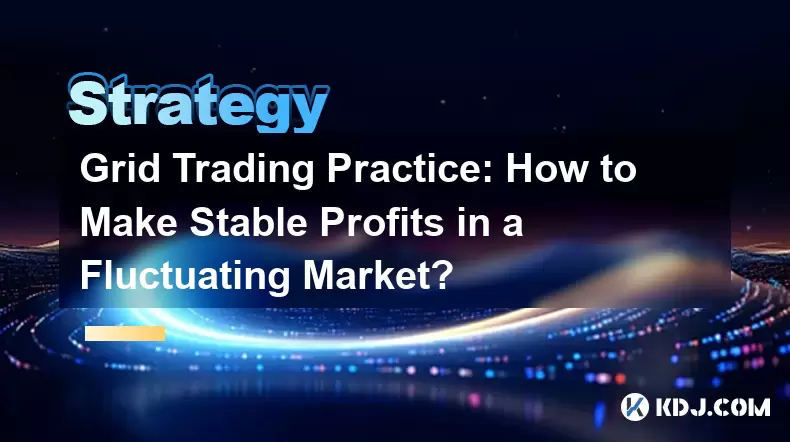-
 bitcoin
bitcoin $122288.232522 USD
0.16% -
 ethereum
ethereum $4480.662914 USD
-0.22% -
 xrp
xrp $2.962747 USD
-2.32% -
 tether
tether $1.000120 USD
-0.05% -
 bnb
bnb $1145.654223 USD
-2.07% -
 solana
solana $227.105217 USD
-1.67% -
 usd-coin
usd-coin $0.999548 USD
-0.02% -
 dogecoin
dogecoin $0.250875 USD
-2.04% -
 tron
tron $0.340654 USD
-0.49% -
 cardano
cardano $0.837968 USD
-2.52% -
 hyperliquid
hyperliquid $48.960449 USD
0.06% -
 chainlink
chainlink $22.049280 USD
-1.33% -
 ethena-usde
ethena-usde $1.000404 USD
0.02% -
 sui
sui $3.586212 USD
0.20% -
 avalanche
avalanche $29.894916 USD
-4.18%
Grid Trading Practice: How to Make Stable Profits in a Fluctuating Market?
Grid trading involves setting multiple buy/sell orders at fixed intervals to profit from market volatility, requiring careful range setting and risk management.
May 23, 2025 at 07:00 pm

Grid trading is a popular strategy among cryptocurrency traders aiming to capitalize on market volatility. This method involves setting up a series of buy and sell orders at predetermined price levels, creating a grid of trades that can help traders profit from small price movements in both upward and downward trends. In this article, we will explore how to implement grid trading effectively and achieve stable profits in a fluctuating market.
Understanding Grid Trading
Grid trading is a systematic approach to trading that relies on setting multiple buy and sell orders at fixed intervals. The strategy is designed to take advantage of the natural fluctuations in the market, allowing traders to buy low and sell high within a specified range. The key to successful grid trading lies in understanding the market's volatility and setting appropriate grid levels.
To start with grid trading, traders need to determine the upper and lower bounds of their trading range. This range should be based on historical price data and current market conditions. Once the range is set, traders can then divide it into smaller intervals, creating a grid of buy and sell orders. For example, if the chosen range is between $10,000 and $12,000, a trader might set buy orders at $10,200, $10,400, $10,600, and so on, with corresponding sell orders at $10,300, $10,500, $10,700, etc.
Setting Up a Grid Trading Strategy
To set up a grid trading strategy, follow these steps:
- Choose a Trading Pair: Select a cryptocurrency pair that exhibits sufficient volatility to make grid trading profitable. Popular pairs include BTC/USDT and ETH/USDT.
- Determine the Grid Range: Analyze the historical price data to establish the upper and lower bounds of your trading range. Ensure that the range is wide enough to capture significant price movements but not so wide that it becomes unmanageable.
- Set Grid Intervals: Divide the trading range into equal intervals. The number of intervals will depend on the trader's risk tolerance and the expected volatility of the market.
- Place Buy and Sell Orders: Set buy orders at the lower end of each interval and sell orders at the upper end. For example, if your grid range is $10,000 to $12,000 with intervals of $200, you would place buy orders at $10,000, $10,200, $10,400, etc., and sell orders at $10,200, $10,400, $10,600, etc.
- Monitor and Adjust: Continuously monitor the market and adjust your grid as necessary. If the market moves significantly outside your grid range, consider resetting the grid to capture new price movements.
Managing Risks in Grid Trading
While grid trading can be profitable, it is not without risks. To manage these risks effectively, consider the following strategies:
- Use Stop-Loss Orders: Implementing stop-loss orders can help limit potential losses if the market moves against your grid. Set stop-losses at levels that align with your risk tolerance.
- Adjust Grid Parameters: Be prepared to adjust your grid parameters based on changing market conditions. If volatility increases, you may need to widen your grid intervals to capture larger price swings.
- Diversify Your Portfolio: Do not put all your funds into a single grid trading strategy. Diversify your investments across different cryptocurrencies and trading strategies to spread risk.
- Regularly Review Performance: Periodically review the performance of your grid trading strategy. Analyze which grids are profitable and which are not, and make adjustments accordingly.
Examples of Successful Grid Trading
To illustrate how grid trading can be applied in real-world scenarios, let's look at a few examples:
- Example 1: A trader sets up a grid trading strategy for BTC/USDT with a range of $9,000 to $11,000 and intervals of $200. As the market fluctuates within this range, the trader's buy orders are filled at lower prices, and sell orders are executed at higher prices, resulting in a series of small profits.
- Example 2: Another trader uses a grid trading strategy for ETH/USDT with a range of $300 to $400 and intervals of $10. Despite the smaller range, the trader benefits from frequent price movements within the grid, accumulating profits over time.
Tools and Platforms for Grid Trading
Several trading platforms and tools are available to help traders implement grid trading strategies effectively. Some popular options include:
- Binance: Binance offers a built-in grid trading feature that allows users to set up and manage grids easily. The platform provides a user-friendly interface and supports a wide range of cryptocurrency pairs.
- KuCoin: KuCoin also offers grid trading functionality, with customizable parameters and real-time monitoring. The platform is known for its competitive fees and extensive selection of trading pairs.
- Trading Bots: Automated trading bots like 3Commas and Cryptohopper can be programmed to execute grid trading strategies. These bots offer advanced features such as backtesting and risk management tools.
When selecting a platform or tool, consider factors such as ease of use, supported trading pairs, fees, and the availability of customer support.
Optimizing Grid Trading Performance
To maximize the effectiveness of your grid trading strategy, consider the following optimization techniques:
- Backtesting: Before implementing a grid trading strategy in a live market, backtest it using historical data. This can help you identify potential issues and fine-tune your grid parameters.
- Adjusting Grid Intervals: Experiment with different grid intervals to find the optimal balance between capturing price movements and managing risk. Smaller intervals may result in more frequent trades but can also increase transaction costs.
- Leveraging Market Trends: Pay attention to broader market trends and adjust your grid trading strategy accordingly. If the market is trending upwards, consider setting a higher upper bound for your grid to capture larger price increases.
- Utilizing Trading Bots: Trading bots can automate the execution of your grid trading strategy, reducing the need for manual intervention and potentially increasing efficiency.
Common Challenges and Solutions
Grid trading, while effective, can present several challenges. Here are some common issues and solutions:
- Market Volatility: High volatility can cause prices to move outside the grid range, resulting in missed opportunities. Solution: Monitor the market closely and be prepared to adjust your grid range as needed.
- Transaction Costs: Frequent trading within a grid can lead to high transaction costs, which can erode profits. Solution: Choose a platform with low fees and consider adjusting your grid intervals to reduce the number of trades.
- Overtrading: Overtrading can occur when grids are set too tightly, leading to excessive trading and increased risk. Solution: Set wider grid intervals and focus on capturing larger price movements.
FAQs
Q: Can grid trading be used for all types of cryptocurrencies?A: Grid trading can be applied to most cryptocurrencies, but it is most effective for pairs with sufficient volatility and liquidity. Popular pairs like BTC/USDT and ETH/USDT are commonly used for grid trading due to their high trading volumes and price fluctuations.
Q: How often should I adjust my grid trading strategy?A: The frequency of adjustments depends on market conditions and the performance of your grid. It is recommended to review your grid trading strategy at least weekly and make adjustments as necessary based on market trends and volatility.
Q: Is grid trading suitable for beginners?A: Grid trading can be suitable for beginners, but it requires a good understanding of market dynamics and risk management. Beginners should start with small investments and use demo accounts or backtesting to gain experience before trading with real funds.
Q: Can grid trading be combined with other trading strategies?A: Yes, grid trading can be combined with other strategies such as trend following or scalping. Combining different strategies can help diversify risk and potentially increase overall profitability. However, it is important to ensure that the combined strategies are compatible and do not conflict with each other.
Disclaimer:info@kdj.com
The information provided is not trading advice. kdj.com does not assume any responsibility for any investments made based on the information provided in this article. Cryptocurrencies are highly volatile and it is highly recommended that you invest with caution after thorough research!
If you believe that the content used on this website infringes your copyright, please contact us immediately (info@kdj.com) and we will delete it promptly.
- BlockDAG, DOGE, HYPE Sponsorship: Crypto Trends Shaping 2025
- 2025-10-01 00:25:13
- Deutsche Börse and Circle: A StableCoin Adoption Powerhouse in Europe
- 2025-10-01 00:25:13
- BlockDAG's Presale Buzz: Is It the Crypto to Watch in October 2025?
- 2025-10-01 00:30:13
- Bitcoin, Crypto, and IQ: When Genius Meets Digital Gold?
- 2025-10-01 00:30:13
- Stablecoins, American Innovation, and Wallet Tokens: The Next Frontier
- 2025-10-01 00:35:12
- NBU, Coins, and Crypto in Ukraine: A New Yorker's Take
- 2025-10-01 00:45:14
Related knowledge

Practical parameter settings for a Bitcoin multi-timeframe moving average system
Sep 18,2025 at 10:54pm
Optimizing Timeframe Combinations for Bitcoin Trading1. Selecting appropriate timeframes is crucial when building a multi-timeframe moving average sys...

How can I filter out false breakouts in Dogecoin high-frequency trading?
Sep 22,2025 at 01:00am
Understanding False Breakouts in Dogecoin Trading1. A false breakout occurs when Dogecoin's price appears to move beyond a defined support or resistan...

Techniques for identifying tops and bottoms in the Bitcoin on-chain NVT model
Sep 20,2025 at 07:54pm
Understanding the NVT Model in Bitcoin Analysis1. The Network Value to Transactions (NVT) ratio is often described as the 'P/E ratio' of the cryptocur...

What does the surge in open interest in Bitcoincoin futures mean?
Sep 20,2025 at 11:18pm
Understanding the Surge in Dogecoin Futures Open Interest1. A surge in open interest within Dogecoin futures indicates a growing number of active cont...

How can I use the Ethereum USDT premium to gauge market sentiment?
Sep 18,2025 at 11:55pm
Understanding the Ethereum USDT Premium1. The Ethereum USDT premium refers to the price difference between USDT (Tether) traded on Ethereum-based plat...

What should I do if Ethereum staking yields decline?
Sep 20,2025 at 06:18am
Understanding the Causes Behind Declining Ethereum Staking Yields1. The Ethereum network transitioned to a proof-of-stake consensus mechanism with the...

Practical parameter settings for a Bitcoin multi-timeframe moving average system
Sep 18,2025 at 10:54pm
Optimizing Timeframe Combinations for Bitcoin Trading1. Selecting appropriate timeframes is crucial when building a multi-timeframe moving average sys...

How can I filter out false breakouts in Dogecoin high-frequency trading?
Sep 22,2025 at 01:00am
Understanding False Breakouts in Dogecoin Trading1. A false breakout occurs when Dogecoin's price appears to move beyond a defined support or resistan...

Techniques for identifying tops and bottoms in the Bitcoin on-chain NVT model
Sep 20,2025 at 07:54pm
Understanding the NVT Model in Bitcoin Analysis1. The Network Value to Transactions (NVT) ratio is often described as the 'P/E ratio' of the cryptocur...

What does the surge in open interest in Bitcoincoin futures mean?
Sep 20,2025 at 11:18pm
Understanding the Surge in Dogecoin Futures Open Interest1. A surge in open interest within Dogecoin futures indicates a growing number of active cont...

How can I use the Ethereum USDT premium to gauge market sentiment?
Sep 18,2025 at 11:55pm
Understanding the Ethereum USDT Premium1. The Ethereum USDT premium refers to the price difference between USDT (Tether) traded on Ethereum-based plat...

What should I do if Ethereum staking yields decline?
Sep 20,2025 at 06:18am
Understanding the Causes Behind Declining Ethereum Staking Yields1. The Ethereum network transitioned to a proof-of-stake consensus mechanism with the...
See all articles










































































